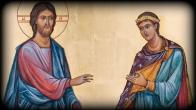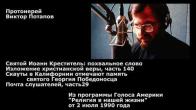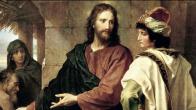You are here
February
- January 21/February 3 -- Sacrificed (Vatopedi, Mt.Athos), "Otrada" or "Consolation" (Vatopedi, Mt.Athos), Panagia Ktitorissa
- January 25/February 7 -- "Assuage My Sorrow"
- January 28/February 10 - Totma-Sumorin Icon
- February1/14 -- "Weeping" Icon in Romania
- February 2/15 -- "Softener of Evil Hearts"
- February 5/18 -- Divnogorsk-Sicillian, "Seeking Out the Lost", Yeletsk Chernigov
- February 12/25 -- Iveron Icon
- February 15/28 -- "Dalmat" Icon
"Ktitorskaya" [Panagia Ktitorissa]
21 January / 3 February
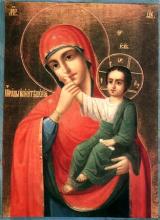 This Icon gained renown in the following manner. When, in the year 862, Arab robbers attacked the Holy Mountain and were already near Vatopedi, the monastery ecclesiarch hid the Ktitorskaya Icon of the Most-holy Theotokos and a Cross in a well behind a marble panel under the church planking, and lit a candle before the holy things. He was seized by the barbarians and imprisoned. After his release 40 days later, he returned to the severely devastated monastery and revealed where the holy things had been hidden; they were found, with a candle burning before them. To this day, a candle burns with an eternal flame before the Icon of the Mother of God. The monks add wax to the lamp, keeping it burning continuously from generation to generation. The Icon is now in the Altar of the Catholicon, and thus is known as the “Altarnitsa.”
This Icon gained renown in the following manner. When, in the year 862, Arab robbers attacked the Holy Mountain and were already near Vatopedi, the monastery ecclesiarch hid the Ktitorskaya Icon of the Most-holy Theotokos and a Cross in a well behind a marble panel under the church planking, and lit a candle before the holy things. He was seized by the barbarians and imprisoned. After his release 40 days later, he returned to the severely devastated monastery and revealed where the holy things had been hidden; they were found, with a candle burning before them. To this day, a candle burns with an eternal flame before the Icon of the Mother of God. The monks add wax to the lamp, keeping it burning continuously from generation to generation. The Icon is now in the Altar of the Catholicon, and thus is known as the “Altarnitsa.”
The Miraculous Ktitorskaya (“Altarnitsa”) Icon of the Most-Holy Theotokos is in the Vatopedi Monastery on Mt. Athos.
The Sacrificed Icon
21 January/ 3 February
It once happened at the Vatopedi Monastery on Mt. Athos, that a deacon, occupied with his assigned tasks of getting everything in the church in the necessary order, was delayed, and came into the refectory after everyone else. When he asked for his dinner, the refectoror expressed his dissatisfaction with him, noting that one should come in at the appointed time. Hurt by this refusal, the deacon became so angry that he went back into the church, and standing before the Icon of the Mother of God, said “How long am I to serve you, O Theotokos? I work and work, and yet I have nothing to show for any of it, not even a piece of bread to bolster my flagging strength. ” With these words, he seized the knife with which he had been cleaning the wax from the lamps, and stabbed it through Her cheek. This Icon had been written on canvas. Blood splashed out of the wound, and the holy image turned pale. The terrified murder fell before the Icon, blind, becoming as one mad, with limbs paralyzed, and quaking like the murderer Cain.
The abbot prayed earnestly for the evildoer, and three years later, learned that he had been forgiven. The Theotokos appeared to the guilty one before his death, and gave him the joy of her forgiveness, but said that his audacious hand would have to come to judgment at the Second Coming of Christ. When, following the custom of Mt. Athos, the bones of the guilty one were exhumed three years after his death, the brethren witnessed an awesome sight. While all of the repentant criminal’s bones remained light, and bore the mark of God’s mercy, the hand which had been so daring remained whole and blackened. It remains so to this day, and is shown to visiting pilgrims. The sacrificed Icon is in the southeast corner of the outer gallery of the chapel of St. Demetrius of Thessalonica.
The "Otrada" or "Consolation" Icon
The “Otrada” or “Consolation” Icon is in the Athonite monastery of Vatopedi, established during the reign of Constantine the Great. In the year 395, Arcadius, son of Emperor Theodosius the Great, who was in a ship near the monastery, fell overboard, and was swallowed by the waters. All of those present assumed that he had perished. With enormous effort, the ship managed to land at Mt. Athos. For a long time, Arcadius’ companions searched the shore, looking for the prince’s body. At the point of exhaustion, they suddenly found him lying peacefully asleep amid the shrubbery bordering the coast. Opening his eyes, Arcadius told them that by the intercession of the Mother of God, he was spared from certain death. This was the blessing extended to mankind by the Mother of God on holy Mt. Athos. In commemoration of this event, the monastery was given the name Vatopedi, i.e. the “bush of the youth.” Emperor Theodosius the Great expanded and enriched the monastery. The altar of a cathedral church was established over the spot where they found the prince. The prince himself, accompanied by Patriarch Nektarios, came from Constantinople for the consecration. The Holy Icon of the Mother of God was placed in this church in a chapel dedicated to Her.
The blessings shown by the Mother of God to the Vatopedi monastery did not cease. In 807, a band of robbers made plans to break into the monastery as soon as the gates were opened at dawn. They intended to slaughter the monks and to loot the monastic treasures. At the close of day, they disembarked on the shore and hid in the shrubbery. However, the Protectress of all Mt. Athos did not permit them to carry out their evil intentions. Matins ended, and all of the brethren dispersed for a short rest. In the church, the rector of the monastery was saying the morning prayer rule near the icon of the Theotokos. He was amazed to suddenly hear clear words of warning: “Do not open the monastery gates today,” said the Most-holy Mother of God, “but instead climb to the top of the walls, and tell the robbers to disperse.” Troubled, the abbot cast his gaze upon the Icon of the Most-holy Virgin, and beheld an astounding miracle: The images of the Mother of God and the Pre-eternal Infant had come to life. The Pre-eternal Infant, extending his right hand to cover the mouth of His Mother, turned His face towards Her, and said, “ No, My Mother, do not tell them; let them be punished.” But the Mother of God, striving to stay the hand of Her Son and Lord with her own, turned Her face to the right, away from Him, and twice more repeated the same words.
The abbot immediately gathered together the brethren, and related what had happened. Everyone was astounded to see that the faces of the Mother of God and of the Pre-eternal Infant, and the outline of the Icon, had changed. Everyone glorified the Most-holy Theotokos for her intercession and effort on their behalf and for the Lord’s showing mercy upon them, through her entreaties on their behalf.
From that day forth, the miraculous Icon has been renowned as the “Otrada” or “Consolation” Icon. The positions assumed by the faces of the Mother of God and of the Savior during the thrice-repeated directions to the abbot remained: The face of the Divine Mother turned to the right, away from the extended right hand of the Pre-eternal Infant. The face of the Mother of God expresses sympathy and love, her look alive with mercy and humility, with a merciful smile of greeting and consolation on her lips. The face of the Pre-eternal Infant-God is otherwise: it is awesome, with anger noticeable in every detail, his gaze filled with severity and implacable judgement.
In memory of the miraculous preservation of the Vatopedi Monastery from being looted, an eternal flame - a constantly burning oil lamp and large candle - burns before the Holy Otrada Icon. All those who enter the ranks of the brotherhood are tonsured in the chapel in which the Miraculous Icon is kept. Moreover, a moleben to the Mother of God is sung there daily.
In the women’s monastery of Tabolzhansk, in the former province of Voronezh, there was a copy of the Icon which had been brought from Mt. Athos. Many of those who came to her with faith received healing from their sicknesses.
Another copy, made not from the original but from the above-mentioned copy, and like it, locally venerated, was blessed in 1854 and was kept in the Holy Virgin-Resurrection Monastery in St. Petersburg. Both of them have now been lost.
"Assuage My Sorrow"
25 January/7 February
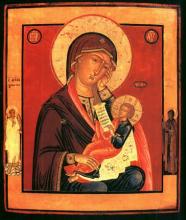 Before every iconographic image of the Most Holy Theotokos we pray to the Queen of Heaven about our spiritual and temporal needs; we ask her to console us in our misfortunes, and to give us spiritual joy.
Before every iconographic image of the Most Holy Theotokos we pray to the Queen of Heaven about our spiritual and temporal needs; we ask her to console us in our misfortunes, and to give us spiritual joy.
'However, among the many miracle-working icons of the Most Pure One, there is one that is actually called "Assuage my Sorrow."
The most ancient of the icons that carries this name was in Shklova in Mogilev Province. Where this miracle-working Icon was painted is unknown: perhaps it was in the Russian Monastery on Mt. Athos or perhaps somewhere else. In a battle that took place in 1640 near Shklova, the soldiers of Tsar Michael Fyodorovitch defeated the Poles. In honor of this victory a copy of the miracle-working Image was translated by the Cossacks to Moscow and placed in the Church of St Nicholas in Zamoskovoretchie (since demolished).
Apparently due both to a fire and to the many renovations of the church, the icon was forgotten for a time. Greatly neglected, it was carelessly left lying, in the bell tower. But the plentiful mercies manifested through it by the Mother of God forced [the people] to remember the forgotten icon.
Tradition relates that the first time this Icon was glorified was in the second half of the 18th century. The miraculous power of the "Assuage my Sorrow" Icon of the Theotokos was revealed in the following manner: a certain woman of noble extraction had long suffered from weakness in her hands and feet. In this case, physicians were of no help. In a vision, she was told to go to Moscow and pray before the icon of the Mother of God bearing the inscription "Assuage my Sorrow;" in the same vision, she was shown the Icon. Not finding that Icon in the church, she turned to the priest for help, who then brought all of the ancient icons down from the bell-tower. One of the icons actually bore the inscription "Assuage my Sorrow." As soon as the woman saw the Icon she exclaimed:
“It is she! It is she!”
After a moleben the ailing woman felt so much stronger that she was able to stand and leave the church unaided.
This miracle occurred on January 25th (Julian Calendar), 1760. Since then, a Feast day in honor of the "Assuage my Sorrow" Icon has been observed. In the church of St Nicholas, the icon was installed in an appropriate place, and an altar was dedicated in its honor.
From all over the city, the faithful and suffering came to Zamoskovorechie to bow down before the newly-revealed icon, and God’s power was revealed in many other miracles. An especially great number of miracles happened during the plague epidemic of 1771. Many copies of the miraculous Icon were made and distributed throughout all Russia; in Moscow alone, four other icons bearing the same name were glorified by miracles.
Today, the miracle-working "Assuage my Sorrow" Icon rests in the Church of St Nicholas-in-Kuznetsy in Moscow.
The Totma-Sumorin Icon
28 January /10 February
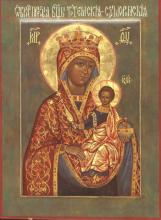 The Sumorin-Totma Icon of the Mother of God gained renown in the Holy Savior-Sumorin Monastery in the city of Totma.
The Sumorin-Totma Icon of the Mother of God gained renown in the Holy Savior-Sumorin Monastery in the city of Totma.
In 1554, after the city residents had appealed to Tsar Ivan the Terrible for permission to establish a monastery in their city, Archbishop Nikandr issued a building certificate to Venerable St Theodosius. The abbot of the Prilutsk Monastery blessed the Venerable One with an icon of the Mother of God to have success in building the new monastery.
The Icon became known as the Sumorin-Totma Icon (Sumorin was Ven. St. Theodosius last name.). After the death of the Venerable Miracle-worker, the Icon was placed in a shrine before his reliquary in the Monastery's Holy Ascension Church. Notably, Venerable St. Theodosius appeared to many people with that Icon in his hands.
The appearance of the "Weeping" Icon of the Mother of God in Romania
1/14 February
This icon of the Mother of God was in a church in the Orthodox Theological Seminary at the Romanian Sokolsky Monastery. In February 1854, it gained renown for the remarkable miracle of shedding tears.
Following the Liturgy served on February 1 in the seminary church, a frightened member of the clerical staff ran up to Hieromonk Isaiah, the ecclesiarch, and said that the icon of the Mother of God was weeping. Several of those serving immediately ran to the church. There they all clearly witnessed, still wet, tears running down from the eyes of the Mother of God.
Bishop Philaret Skriban, the seminary rector, also witnessed this miracle. He removed the icon of the Mother of God from its frame, carefully examined it, used a towel to wipe off the tracks of the tears, and put the icon back in its place. Then, after directing everyone to leave the church, he looked around throughout the church, and then locked it up.
Several hours later, the seminary professors and instructors accompanied their rector into the church for Vespers, and all were amazed to see the same miraculous flowing of tears from the eyes of the Theotokos depicted on the Icon. The seminary rector immediately served a Moleben and Akathist to the Mother of God.
Soon, all of Romania learned of this miraculous event, and people from all parts of the country began to arrive at the Sokolsky Monastery to bow down before the newly revealed miraculous Icon of the Theotokos. The marvelous flowing of tears sometimes happened every day, and sometimes two, three, or four days apart. As a result, many people were able to see at first hand the actual miracle of weeping, and could personally bear witness to it. Those who did not see the actual miracle could bear witness to it by seeing the tracks of the dried tears on the surface of the icon.
Yet, there were those who doubted...
The Weeping Icon of the Mother of God appeared during the Crimean War. Because of that war, the Principality of Moldavia was occupied by Austrian troops. Their commanding officer, General Paar, sent a staff officer to the Sokolsky Monastery with instructions to carefully investigate the reported miracle and to give a report of his results.
The colonel obeyed the orders. In the Monastery, he made a thorough examination of the Weeping Icon of the Mother of God. At the time, it was not weeping. Finding nothing out of the ordinary, he put the Icon back into its frame. Then he took a lighted candle, and with the help of the candle made a careful examination of the face of the Mother of God. Suddenly two little diamond-bright tears shone in the eyes of the Mother of God, and tears began to flow. The officer recoiled in terror, and exclaimed, "It's weeping? That is a great miracle! Fathers, pray unto God!"
The colonel reported what had transpired to his commanding officer. His report on the miraculous flowing of tears from the icon is of unquestionable importance, for he had come to Sokolsky Monastery without any faith in the possibility of such a miracle, but left with faith, convinced that it was indisputable fact.
This was not the only evidence that a true miracle had taken place. There were many other eyewitness accounts, including accounts by individuals whose sincerity there would be no reason to question.
The account provided by Bishop Melkhizedek of Roman merits particular attention. He was one of the first to be an eyewitness to this miracle, and at the time was a professor at the seminary in the Sokolsky Monastery. Reminiscing 35 years later about seeing tears pour from the eyes of the Mother of God, this elder said that for a long time he pondered the question: Who do these tears of the Mother of God signify? He became convinced that in times past there had also been such icons, which from time to time wept tears, and that similar events always presaged difficult trials for the Christ's Church and for the homeland.
History supported this elder's conclusion. Soon after the miraculous shedding of tears, the Moldavian Principalities were subjected to severe trials. The Sokolsky Monastery also suffered great difficulty. It had as great an importance to Romanians as the St. Sergius Lavra has to us, the Russian people. Romania's great religious and educational center was destroyed. The seminary was moved to Jassy, and the local instructors and monastics were dispersed. Thus, where the glorious historical seminary had stood, serving for almost a century as a nursery for religious education, there remained only a single, small, elementary school.
2/15 February
 "Softener of evil hearts"… What a great deal of hope there is in the name of this Icon: hope that some day justice will triumph on earth, that people will become kind and charitable, will begin to love one another. How difficult that is in our embittered world, and sometimes the mere sight of someone else's suffering is enough to soften our own evil hearts...
"Softener of evil hearts"… What a great deal of hope there is in the name of this Icon: hope that some day justice will triumph on earth, that people will become kind and charitable, will begin to love one another. How difficult that is in our embittered world, and sometimes the mere sight of someone else's suffering is enough to soften our own evil hearts...
This Icon is also called the "Simon’s Prophecy" Icon. According to the Evangelist Luke, the Holy Spirit told righteous Elder Symeon the God-receiver that he would not die until he had seen the Messiah. And thus when, forty days after the Divine Infant's birth His parents brought Him to the Temple of Jerusalem, Symeon "was inspired" to come there as well, and took the Infant into his arms (hence the title "God-receiver"), and pronounced those famous words which ever since have been spoken at the conclusion of each Vesper service, and which are known as the Prayer of St. Symeon the God-receiver: "Now lettest Thou Thy servant to depart in peace, O Master, according to Thy word…" After that, he blessed St. Joseph and the Most-pure Mother of Our Lord, and addressed Mary with that same prophecy. It was after he had blessed St. Joseph and the Most-immaculate Mother of the Savior, that he addressed Mary with that same prophecy: "Behold, this child is set for the falling and rising again of many in Israel, and for a sin which shall be spoken against. Yea, a sword shall pierce through thy own soul also, that the thoughts of many hearts may be revealed." Just as Christ would be pierced with nails and a spear, so the soul of the Most-pure One would be pierced by a certain weapon of sorrow and pain in the heart, when she saw her Son's suffering. After that, the heretofore hidden thoughts of the people regarding the Messiah would be revealed, and they would face a choice: to be with Christ, or against Him. Such an interpretation of Symeon's prophecy became the subject of a number of icons of the Theotokos. All those who turn to them in prayer sense that with the softening of evil hearts comes an easing of spiritual and physical suffering. People come to recognize that when they pray for their enemies before such icons, their feelings of enmity are softened, and that internecine strife and hatreds abate, giving way to kindness.
Evidently the "Softening of Evil Hearts" Icon came from southwestern Rus', but unfortunately there has never existed any supporting historical documentation of its origins. Even when and where It appeared is unknown. The Immaculate One is depicted on the "Softening of Evil Hearts" Icon with her heart pierced by seven swords—three on either side, or one below. In Sacred Scripture, the number seven usually indicates something's fullness and abundance. In this case, it is the fullness of that boundless sorrow, pain and "sickness of the heart" experienced by the Theotokos during her earthly life. Sometimes, the Pre-eternal Infant is also depicted resting on her knees.
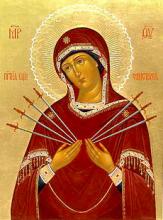 Another Icon, the "Seven Swords" Icon is quite similar to the "Softening of Evil Hearts" Icon. They differ only in the arrangement of the swords: on the "Seven Swords" Icon, there are three swords on the right, and four on the left. It is commemorated on August 13, Old Calendar.
Another Icon, the "Seven Swords" Icon is quite similar to the "Softening of Evil Hearts" Icon. They differ only in the arrangement of the swords: on the "Seven Swords" Icon, there are three swords on the right, and four on the left. It is commemorated on August 13, Old Calendar.
During World War II, in the southern part of Voronezh Province, in a place known as Belogorye ("White Hill"—a reference to the chalk cliffs on the right bank of the Don near the town of Pavlovsk), there was a detachment of Italian mountain artillery men, allies of the Nazis. During the second half of December 1942, soldiers under the command of Lieutenant Giuseppe Pereigo found a "Softener of Evil Hearts" Icon in a bombed-out house. They gave it to their military chaplain, Fr. Policarpo, who was from Valdania. According to the locals, the Icon had come from the Belogorye Cave Monastery of the Resurrection near Pavlovsk. The Italians called the Icon the "La Madonna del Don," the Madonna of the Don—not to be confused with the Donskoy Icon of the Mother of God. After the Ostrog-Rossoshansk campaign by Soviet forces in January 1943, the remnants of the decimated Italian contingent left Russia. Chaplain Policarpo took the "Madonna of the Don" with him to Italy, where in Mestra, a part of Venice, a chapel was built to house it. It remains a center of mass pilgrimages by friends and relatives of the Italian soldiers who perished in Russia.
Finally, there is another miraculous icon of the same type in the cathedral in the town of Zhizdra, near Bryansk, in southwestern Kaluga Province. It was known as the "Strastnaya" (i.e., Passion) Icon or, as it was described in the Cathedral inventory, the "And a sword shall pierce through thy soul also" Icon. It is also commemorated on August 13, the same day as the "Seven Swords" Icon and the far better known "Passion" Icon, which is of an entirely different appearance (the original miracle-working icon is in the Monastery of the Passion in Moscow. On it, near the "Hodigitria" image are two Angels and the implements of the Lord's Passion—the Cross, the sponge, and the spear. Unlike in other "Passion" icons, in the Zhizdra Icon the Immaculate One is depicted in an attitude of prayer. With one hand she supports the Infant lying at her feet; with the other hand she guards her breast against the seven swords pointed toward it.
Divnogorsk-Sicilian Icon
5 / 18 February
The Divnogorsk-Sicilian Icon of the Mother of God was named after the Divnogorsk Monastery of the Dormition in the former Ostrogozhsk district of Voronezh province, the place to which it was first translated and in which it gained renown. It is also called "Sicilian" because of its place of origin. According to tradition, this icon was brought by the pious elders-monastics, Xenophont and Joasaph, from Sicily to "Divy," the "Wonders" or "Wondrous Mountains." Probably the monks, who presumably were Orthodox Greeks, came here no earlier than the end of the fifteenth century. Xenophont and Joasaph founded the monastery in a picturesque location overlooking the Don River, at its confluence with the Tikhaya Sosna River. The place name "Wonders" or "Wondrous Mountains" stems from the remarkably shaped chalk columns found throughout these hills. It is believed that Xenophont and Joasaph lived in a cave (where the church of Saint John the Forerunner was subsequently erected), and that they themselves carved out the first church in the chalk column, and in it placed the icon of the Mother of God which they had brought from Sicily. It was also here that they found eternal rest. On the icon, the Sicilian (Divnogorsk) Mother of God is depicted seated upon the clouds. In her right hand is a blooming white lily, while with her left arm, she supports the Divine Infant, Who is seated in state upon her knees. In His left hand, the Saviour holds a lily, while with his right, He blesses. Surrounding the image of the Mother of God are eight angels, of whom two are depicted below her, on bended knees and with their hands stretched upward. Above the head of the Mother of God, in the form of a dove, is the Holy Spirit. The miraculous icon became expecially renowned beginning in 1831, when cholera was rampant. In Korotoyak, about eight kilo-meters away, the Most Blessed Virgin appeared in a dream to an elderly resident named Catherine Kolomenskaya. She appeared just as she was depicted in the Divnogorsk Icon, and directed that her icon be taken, and a moleben served before it. The miraculous icon was transferred to Korotoyak, and, after fervent common prayers were offered before the holy icon, the cholera ceased. At the same time, by the interecession of the Mother of God, the city of Ostrogozhsk was saved then from cholera. In the years 1847 and 1848, rescues from cholera also came to the people of Korotoyak and Ostrogozhsk through the miraculous intercession of the Mother of God; these occurred after the Icon was carried in a Procession of the Cross around the cities. According to tradition, the celebration of the miraculous icon on the 5th of February was established by the first inhabitants of the monastery, Xenophont and Joasaph.
"Seeking Out the Lost" Icon
5/18 February
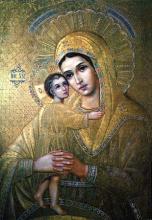 From days of yore, the Russian people, firmly believing in the almighty help rendered by the Most-holy Theotokos, have given to her the title “Seeker-out of the Lost,” i.e. the ultimate refuge, the last hope of those who are perishing.
From days of yore, the Russian people, firmly believing in the almighty help rendered by the Most-holy Theotokos, have given to her the title “Seeker-out of the Lost,” i.e. the ultimate refuge, the last hope of those who are perishing.
Reliable information about the origin of the ‘Seeker-out of the Lost” Icon has not survived. There exist several miraculous icons bearing that name, icons through which the Mother of God has shown her mercy toward people who had already crossed the threshold of perdition.
In the mid-17th Century, in the village of Bor in Kaluga Province, while traveling on the Feast of the Baptism of Our Lord a pious peasant named Theodot Obukhov was caught up in a blizzard. His exhausted horses stopped at an impassible ravine. Seeing no means to save himself, Obukhov lay down in his sleigh and began to fall asleep, unconscious of the fact that he would freeze to death. However, in those awful moments, he called out with all his being to the Queen of Heaven for help, and promised to make for his parish church a “Seeker-out of the Lost Icon. She heard his heart-felt prayer: In a neighboring village, a certain peasant suddenly heard a voice coming from outside his window, and saying “Take [him].” He went out and saw Obukhov, half-frozen, in his sleigh. Upon recovering, Obukhov immediately kept his promise and ordered a copy of the Icon from the Church of St. George in the town of Volkhov, Orel Province. From that time on, the Bor “Seeker-out of the Lost” Icon gained renown for a multitude of miraculous signs and wonders. Other miraculous “Seeker-out of the Lost” that have gained renown include: one from the village of Malizhin, Kharkov Province, that appeared in 1770 and on three occasions saved the villagers from a cholera epidemic; one from the village of Krasnoe, Chernigov Province, and one from Voronezh, Kozlov Tambov Province. In 1835 a church dedicated to the “Seeker-out of the Lost” Icon was consecrated at the Alexandrov Orphans’ Institute in Moscow.
Of special interest is the tradition related to the “Seeker-out of the Lost” Icon of the Mother of God in the Moscow church known as the Church of the Resurrection (in honor of the dedication of the Church of Christ’s Resurrection in Jerusalem). That icon had been translated from the Church of the Nativity of Christ on Palashev Lane. Its last owner, was a widower on the brink of utter poverty. His fervent prayers to the Most-holy Theotokos saved him from despair and decided the fate of his orphaned children. The man considered himself unworthy of having a miraculous icon in his home, and gave it to the church. In 1812 the French looted the Palashev church. The desecrated Holy Icon was found, broken into three pieces, lying amid all kinds of rubbish. The finding of the Icon was accompanied by a multitude of miraculous healings. Brides would turn to the Icon to ask for a marriage that was unto salvation. People who had fallen into alcoholism, who were perishing in poverty, or who suffered from diseases, came to her in prayer, as did mothers whose children were perishing. To all, the Queen of Heaven sends down her assistance and support.
Troparion
Seek us out, who are perishing. O Most-holy Virgin, thou dost not punish us according to our sins, but hast mercy on us according to thy love for mankind: do thou deliver us from hell, sickness and need, and save us.
YELETSK CHERNIGOV ICON
5/18 February
The Yeletskaya Miraculous Icon of the Most-holy Theotokos was in Chernigov, in the men’s Monastery of the Dormition in Yeletsk. In 1060, St. Anthony of the Caves was driven from Kiev by Great Prince Izyaslav. He removed to the Chernigov area, and in a remote place dug out a cave in which to remain in seclusion. At that time, he found an icon of the Mother of God, standing in a fir tree. At the place it appeared, he founded a monastery dedicated to the Dormition of the Mother of God. Both the Icon that appeared and the monastery are called “Yeletsky” [from the Russian for fir tree: “yel’”]. The Icon was lost in the early 17th Century, during the destruction of the monastery by the forces of Polish King Sigismund III, but in 1676 a surviving copy that had been made from the original was donated to the monastery as a replacement.
Rejoice, Keeper of the Portal most gracious,
who dost open to the faithful the doors of Paradise
(Akathist refrain)
The Tradition
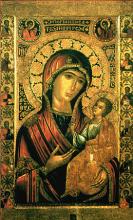 The original Miraculous Icon of the Iveron Mother of God is on Mount Athos, the famous center of Orthodox monasticism (known also as Agion Oros - Greek for the "Holy Mountain"). By tradition, it was painted by the apostle and evangelist Luke.
The original Miraculous Icon of the Iveron Mother of God is on Mount Athos, the famous center of Orthodox monasticism (known also as Agion Oros - Greek for the "Holy Mountain"). By tradition, it was painted by the apostle and evangelist Luke.
In the 9th century, this Icon was in the possession of a widow who lived in Nicea. This town in Asia Minor no longer exists, but in its time it was the venue for two Ecumenical Councils; the first, which composed the first eight articles of Nicean Creed, and the seventh, which reinstituted the veneration of icons after a lengthy struggle with the iconoclast heresy, which had erroneously equated the veneration of icons to idol worship.
It was during the reign of the iconoclast Byzantine emperor Theophilus that soldiers came to the house of the widow, where in a small chapel the Iveron Icon of the Mother of God occupied a place of honor. One of the soldiers struck the Icon with his sword, and immediately blood began to flow from the gashed cheek of the Virgin. Shaken by this miracle, the soldier instantly repented, renounced the iconoclast heresy, and entered a monastery. On his advice, the widow concealed the Icon in order to avert its further desecration. After praying for guidance before the Icon, the widow put the Holy Image into the sea. To her immense surprise and joy the Icon did not sink but, remaining upright, drifted away in a westerly direction. Fleeing persecution, the widow's son left Nicea and went to Mt. Athos where he led a saintly life as a monk to the end of his days. There he recounted the story of how his mother had set the Holy Icon upon the waves, and this story was handed down from one generation of monks to another.
Many years later this Icon appeared on the Holy Mountain ("in a pillar of fire" as Athonite tradition recounts) from the sea, close by the Iveron monastery. At that time the holy monk Gabriel was one of the brotherhood in this monastery. The Mother of God appeared to him in a vision and directed him to convey to the abbot and brothers of the monastery that She wished them to have Her Icon as their help and salvation. She told Gabriel to approach the Icon on the waters without fear and take it with his hands. Obedient to the words of the Mother of God, says Athonite tradition, Gabriel "walked upon the waters as though upon dry land," took up the Icon and brought it back to the shore. The icon was then brought into the monastery and placed in the altar. On the next day the Icon disappeared from the sanctuary, and was found on the wall beside the monastery gate. It was returned to the altar, but the next day it was again found by the gate. This recurred several times, until the the Holy Virgin revealed to the monk Gabriel that it was not Her wish for the Icon to be protected by the monks, but that She wished to protect them. After this, a church was built near the monastery gate where the Icon resides to this day. In connection with the name of the monastery the Icon came to be known as the "Iveron" Mother of God, and because of its location, the "Portaitissa," or "Gatekeeper." In addition to many miraculous hearings, the Holy Virgin demonstrated Her protection of the Iveron Monastery during various assaults by Saracen pirates.
News of this wonder-working Icon reached Russia through pilgrims who had visited Mt. Athos. In the 17th century Archimandrite Nikon of Moscow (later to become Patriarch) asked the abbot of the Iveron monastery to send a copy of the Icon to Russia, and this request was fulfilled. The copy of this Icon also began to work miracles and a special chapel was built for it next to the Kremlin walls in Moscow, where it was especially revered by the Russian people until the Revolution of 1917. The chapel was destroyed by the Bolsheviks and the fate of the Icon is not known.
The Contemporary Miracle
 In 1982, a Chilean convert to Orthodoxy, Jose Munoz, in the company of two friends, embarked from Canada to the ancient bastion of Orthodox monasticism, Mt. Athos, on a pilgrimage. An art teacher by profession, he is also an iconographer, and therefore wished to visit some of the sketes (small monastic communities dependent upon one of the 20 major monasteries of Athos) and monasteries which specialize in icon painting. One of the friends who had accompanied Jose decided to become a monk and remained on Mt. Athos in one of the smaller sketes; Jose and his other companion directed themselves towards the Danilov skete, where icons are painted in the ancient Byzantine style using the egg tempera technique.
In 1982, a Chilean convert to Orthodoxy, Jose Munoz, in the company of two friends, embarked from Canada to the ancient bastion of Orthodox monasticism, Mt. Athos, on a pilgrimage. An art teacher by profession, he is also an iconographer, and therefore wished to visit some of the sketes (small monastic communities dependent upon one of the 20 major monasteries of Athos) and monasteries which specialize in icon painting. One of the friends who had accompanied Jose decided to become a monk and remained on Mt. Athos in one of the smaller sketes; Jose and his other companion directed themselves towards the Danilov skete, where icons are painted in the ancient Byzantine style using the egg tempera technique.
After eight hours of climbing uphill on rough terrain, they were very tired and decided to stop at a skete which they could see on the the Mountainside below. This skete, dedicated to the Nativity of Christ, is very poor and its 14 monks keep a strict monastic rule. The abbot, Fr. Klimentos, greeted them warmly and offered traditional Athonite hospitality. Then he took them to see the skete's icon-painting studio.
As soon as he entered the studio, Jose felt an immediate and indescribable attraction to a copy of the Iveron Icon of the Mother of God which hung on one of the walls. As he later explained, his heart felt as though it had 'leaped or turned over. " He asked whether he could buy this Icon, but was told repeatedly that it was one of the first icons which had been painted at this skete ( by one Fr. Chrysostomos in 1981) and was not for sale at any price.
That night at a divine service in the church of the skete, during the singing of the angelic hymn to the Theotokos "It is Meet" (one of the chief prayers of the Orthodox Church to the Mother of God), Jose fell to his knees and begged the Mother of God to make it possible for him to take the Icon back with him into the world, where "we have need of You." Immediately he felt an assurance that somehow his prayer would be answered. The next morning, as Jose and his friend were about to depart, the abbot appeared holding the Icon and said to Jose that it pleased the Mother of God for Her Icon to go with him to North America.
Jose and his companion went down the mountain and took the the boat towards Daphne, a port on the western shore of the peninsula. On the way, Jose heard a strong inner voice which bade him: "Go to the Iveron monastery and touch your Icon to the original wonder-working Iveron Icon." This they did.
Upon arrival at the Iveron monastery they waited three hours before a monk came to open the church which houses the original "Portaitissa." Jose asked that the protective icon case be opened so that his Icon could be placed upon the original Portaitissa in order to be directly blessed by the Mother of God. The monk was suprised, but agreed to Jose's request when it was explained to him that Jose and his companion wished to take the blessing of the Mother of God to the West where Her intercession is much needed.
Returning to his home in Montreal, Canada, Jose placed the Iveron Mother of God in his icon corner, where he also kept relics of the saints from the Kiev Caves monastery and of the Grand Duchess Elizabeth (one of the New Martyrs of Russia).
Jose began to read a daily Akathist (hymns of praise) before his newly-acquired Icon. At about 4 a.m. on Nov. 24, 1982 (three weeks after his return from Mt. Athos), Jose woke up to the smell of a very strong fragrance, as though someone had spilled a bottle of exquisite perfume. He thought at first that the fragrance emanated from the relics but later, when he stood before the Icon to say his morning prayers, he saw that the hands of the Mother of God were streaked with oil. Jose assumed that a friend who was sharing the house had spilled some oil onto the Icon while adjusting the flame of the vigil lamp hanging before it, but the friend denied touching the lamp. When Jose wiped the Icon, he discovered that it was the source of the wonderful fragrance which had by now filled the whole house.
Upon the advice of a local Orthodox clergyman, the Icon was taken to church and placed on the altar. During the entire liturgy, myrrh flowed from the hands of the Christ Child. Since that time, with the exception of several days during Holy Week, when the Icon is absolutely dry, the myrrh has continued to flow almost uninterruptedly. (Holy Myrrh is a sweet, fragrant oil which was used in the Old Testament for the anointing of kings. In contemporary Orthodox church practice, a newly born Christian is anointed with Holy Myrrh during which the words "The seal of the gift of the Holy Spirit" are said by the priest.)
In the years since, Jose has traveled to many cities and parishes where the Icon has been venerated to the great joy and consolation of the faithful.
Wherever the Icon goes, there are always many questions. Some people initially have doubts. A scientist in Miami was astounded to see that the back of the Icon remained perfectly dry. He later surreptitiously chipped off a small piece of the board on which the Icon is painted for scientific analysis: it was found to be ordinary pine wood, nothing more.
At some times the myrrh flows in greater abundance than at others. During the consecration of a bishop in Montreal there was such an outpouring of the myrrh, that it streamed down from the analogion (lectern on which icons are kept in Orthodox churches) onto the floor. On another occasion, in Florida, the myrrh was seen to rise forth from the hands of the Mother of God and the Christ Child as though it were being pressed from within. Nobody has any power to regulate the flow of the myrrh, it moves to the will of God and His Most Pure Mother.
The Icon is kept in a frame about two inches deep and measures about 12 X 18 inches. At first the myrrh flowed only from the hands of the Mother of God, from the star on Her left shoulder and, occasionally, from the hands of Our Lord Jesus Christ. Yet in March 1985, during a Lenten service, even the frame and glass of the Icon began to exude myrrh in such quantities, that the cloth of the analogion on which it lay was totally saturated. There is always a layer of cotton wool at the base of the Icon to absorb the myrrh: pieces of this cotton are distributed to the faithful.
Although there have already been several cases of physical healing (not only among Orthodox, but Catholics and Protestants, too), the purpose of the Mother of God seems to be directed more at the healing of souls. Many who have stood before the Icon have testified to this, experiencing not only compunction and repentance, but consolation at the same time.
As mentioned earlier, the flow of myrrh ceases during Holy Week. It ceases on Holy Monday. After the liturgy on the morning of Great Saturday, a light dew of myrrh forms on the Icon, its case and protecting glass. During Matins (the midnight service at which the glorious Resurrection of Our Lord is proclaimed), when the procession of clergy and faithful, holding icons and banners, leaves the church, the Icon begins to exude myrrh in such quantities, that it covers the hands of the person who is carrying it.
This is not the first time that the Orthodox Church has witnessed such a miracle. In the 19th century the Surety-of-Sinners Icon in Moscow exuded myrrh with which the sick were anointed and received healing. Earlier, there was a myrrh-streaming icon of the Mother of God in the Tolga monastery in Yaroslavl, and there have been others.
What is the meaning of this extraordinary manifestation of God's grace in our time? It has been observed that in the history of the Church such miracles have occurred in times of great tribulation; we saw this in the Apostolic times, and, more recently, in Russia, where the Church has suffered cruel persecution for 70 years. The miracles strengthen the faithful and prepare them to endure trials. The appearance of the myrrh-streaming Icon in our time may well signify a period of further great trials for the Russian Orthodox Church and, at the same time, offer consolation that the Mother of God will be a Protectress of the faithful: Unto whomsoever much is given, of him shall much be required.
Least Among the Brethren
 Jose Munoz formed the desire to become a monk while still a boy in Chile. He became converted to Holy Orthodoxy as a youth and began to lead a monastic life as best he could within the confines of the world, although he did not enter a monastery. Later he moved to Canada and continued to observe this way of life. When the miracle of the myrrh-streaming occurred, Jose vowed that he would never seek worldly gain from the Icon. Therefore any collections taken up during church services at which the Icon is present are sent to the poorest monasteries and sketes on Mt. Athos and/or to help those persecuted for their faith in the Soviet Union and their families. Jose never accepts any money for himself while traveling with the Icon, although he is forced to take much time off from his teaching and icon painting, which are his only sources of gainful employment.
Jose Munoz formed the desire to become a monk while still a boy in Chile. He became converted to Holy Orthodoxy as a youth and began to lead a monastic life as best he could within the confines of the world, although he did not enter a monastery. Later he moved to Canada and continued to observe this way of life. When the miracle of the myrrh-streaming occurred, Jose vowed that he would never seek worldly gain from the Icon. Therefore any collections taken up during church services at which the Icon is present are sent to the poorest monasteries and sketes on Mt. Athos and/or to help those persecuted for their faith in the Soviet Union and their families. Jose never accepts any money for himself while traveling with the Icon, although he is forced to take much time off from his teaching and icon painting, which are his only sources of gainful employment.
When asked why he thinks he was chosen for such a miracle, Jose replies that, knowing his many weaknesses, he is at a loss to explain this; he feels that perhaps it was because God often reveals himself through the very least of His servants, and that as a convert, he feels himself to be the "least among the brethren." He regards himself not as the owner, but merely the custodian of the Icon, which properly belongs to the entire body of the faithful. From his childhood his mother, who is a devout Roman Catholic, taught him to love the Most Pure Virgin, therefore he always prayed to Her, though never asked Her for any signs or miracles.
Glory be to Our Lord Jesus Christ for manifesting through Jose, the 'least of His servants," the wonder-working Iveron Icon of the Mother of God!
Washington, D.C. 1995
The Dalmat Icon of the Mother of God was found in the Dormition Monastery in the town of Dalmatov, in the province of Perm. The monastery was established in 1644 by the monk Dalmatus, who, out of humility, left the Nevyansk Monastery upon learning that he was to be awarded the rank of abbot. Taking with him only the icon of the Dormition of the Mother of God, he moved to the Shandrinsk district and settled on the bank of the Iseta River in 1644. Upon hearing of this, the Tiumen Tatar Ilegei, to whom the land belonged, set out together with his relatives to drive Dalmatus out and to put to the torch everything he had built. Along the way in the night, though, Ilegei had a vision of the Mother of God, arrayed in rich vestments, wearing a crown, and holding a flaming sword in her hand. She strictly forbade him to harm Dalmatus, and directed that he cede to him the land, so that a monastery might be built there. After seeing this vision, Ilegei and his retinue meekly approached the monk Dalmatus. For the monastery, they gave him all of the land he had occupied, as well as other gifts. Dalmatus, whose name in the world was Dimitry Ivanovitch Mokrinsky, erected a wooden church and cell. This took place in 1646. In 1664, the Siberian prince Devlet-Girei attacked, looted and burned the monastery. However, the icon of the Theotokos remained unharmed. Only a single spot – a spot on its back which a Muslim had touched – was scorched. Later the monastery was renewed by archimandrite Isaac. A stone church was erected, and within it was installed the icon which Dalmatus had brought from the Nevyansk monastery. The Dalmatov Monastery, beautified by gifts offered by people who came from throughout the land to pray there, gained renown, and became the best-known monastery in all of Siberia.
PARISH LIFE
RECENT VIDEOS
Address of our Cathedral
Subscribe to our mailing list
While all the materials on this site are copyrighted, you may use them freely as long as you treat them
with respect and provide attribution on the Russian Orthodox Cathedral of St.John the Baptist of Washington DC.



